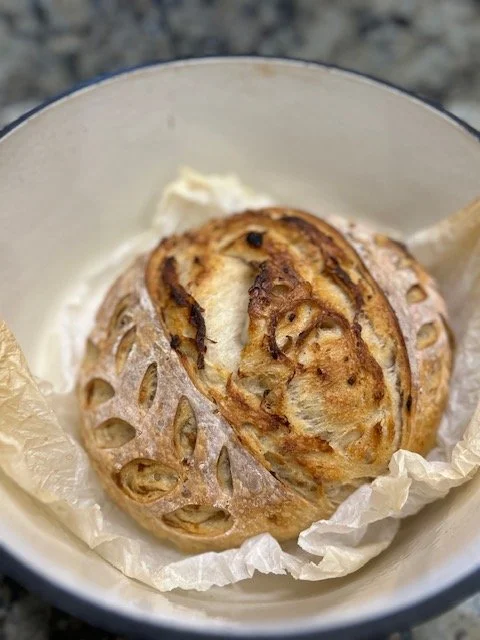French Onion Sourdough Bread
This is one of those recipes that I couldn’t stop thinking about after seeing a post where a baker used a packet of Lipton French Onion Dip mix in their sourdough. It sounded delicious but I didn’t want all the added chemicals that come with prepackaged mixes, so I decided to start working on my own. Can you use the Lipton mix to cut corners? By all means, go for it! We just don’t do that here at BSBC. If I’m going to boast of the health benefits of my products, I can’t in good conscience add preservative-laden ingredients to my breads.
Let’s get started! You can print this recipe HERE.
You are going to start with the following ingredients:
120g or 1/2 Cup Strong Bubbly Sourdough Starter
225g or 1 Cup Water
100g or 1/2 Cup Beef Stock
500g or 4 Cups Bread Flour
12g or 2 TSP Salt
1/4 Cup French Onion Seasoning Mix (see below)
2 TBSP Salted Butter (for shallots)
110g or 1 Cup Shallots, diced
GRAMS TO OUNCE CONVERSION COMING SOON
French Onion Seasoning Mix:
3/4 Cup Minced Onions (I use McCormick’s Chopped Onions)
1 TBSP + 1TSP Onion Powder
1/4 TSP Celery Seeds (grind up with the back of a spoon)
1/4 TSP Sugar
1/4 TSP Pepper
1/8 TSP Paprika
Equipment:
Stand Mixer not required as you can mix this by hand.
Banneton Basket or Medium Bowl
Dutch Oven (2 loaf pans work as well)
Digital Thermometer (I use this one from Amazon)
Instructions
Start by mixing the 120g sourdough starter with the 225g water and 100g of beef stock. I like to use my Kitchen Aid stand mixer to mix sourdough with the dough hook attachment and let it run for about 20 seconds until the water has turned cloudy from the starter.
Add the 500g of bread flour and 1/4 cup of the French Onion Seasoning mix you made from the recipe listed above. The bread has a strong onion flavor. You can reduce the seasoning mix for a lighter taste. You should have enough left for another loaf if you wish to make second one. Once it has been partly mixed in the stand mixer bowl (about 45 seconds), add the 12g of salt and let it mix thoroughly. The dough will be very sticky, but easy to remove with a spatula and wet fingers.
Place the dough in a glass, plastic, or stainless-steel mixing bowl and cover.
Cook the shallots in a skillet with the 2TBSP of butter until golden and translucent. Set aside to cool.
I like using shallots for their flavor, but any onion will work fine.
After 30 minutes, perform your first set of stretches and folds.
Wait another 30 minutes, then add your cooled shallots and perform another set of stretches and folds.
Perform 1-3 more stretches and folds every 30 minutes until the dough starts holding its shape. It usually only takes me 3 series of stretches and folds until it’s ready to complete bulk fermentation.
Cover the bowl and leave on the counter for 5-8 hours depending on the temperature of your kitchen. It may take longer during the winter due to cooler temps. Once it has risen 50%-75%, has a slightly domed surface, and cleanly pulls from the bowl’s surface, dump out onto a lightly floured surface and shape into a boule or loaf.
Place into a banneton basket, a medium sized bowl also works great with a tea towel to line the bottom, then let it rest for 10-15 minutes. Once rested, stitch together (see Notes) as needed, then cover and place in the fridge for 12-36 hours.
When you are ready to bake, preheat the oven to 450 degrees and place a Dutch oven inside to heat up. Make sure the Dutch oven has adequate time to heat up as it will take longer than the oven. I like to wait 30-45 minutes before baking my bread. If you are using two loaf pans, allow the oven to heat up for about 30 minutes
Place your dough in the Dutch oven and bake for 35 minutes. Remove the lid, then bake another 6-8 minutes until the bread reaches an internal temperature of 204-210 degrees. When using the double loaf pans, place your dough into a loaf pan, then cover it with the other. This will trap in steam and allow for a better rise. Allow it to bake covered for 30 minutes, then another 6-10 minutes uncovered.
Allow to cool, slice, and enjoy!!
NOTES:
SOURDOUGH STITCHING creates tension in your sourdough and is completed once the loaf has been shaped and placed in a banneton basket, bowl, or loaf pan. You complete this step by gently grabbing small portions of dough on the sides of the loaf and stretching them to the center. Repeat this step until all the side sections of the dough have been pulled and gently pressed to the center.






